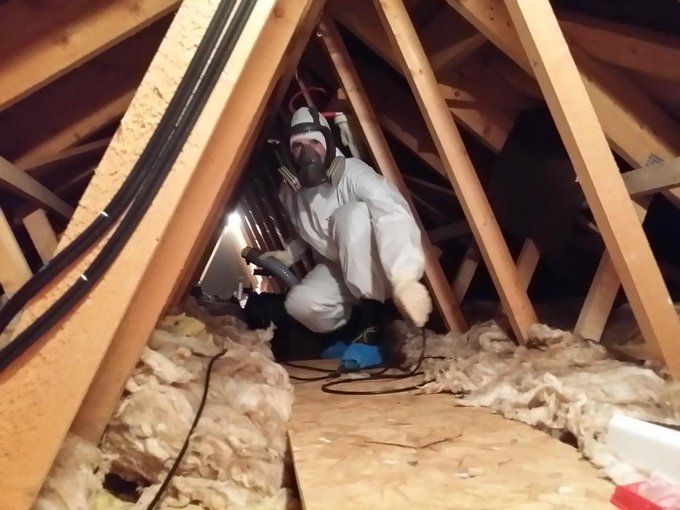
Sanitation
Sanitation is a crucial step following a rodent infestation to ensure the health and safety of residents and to prevent future infestations. Rodents, such as rats and mice, can leave behind a variety of contaminants that pose serious health risks and can cause significant damage to property. Here’s why sanitation is essential after a rodent infestation:
DSV Sanitizer
DSV grade sanitizer, or Disinfectant, Sanitizer, and Virucide, is a powerful cleaning agent specifically formulated for comprehensive sanitation purposes, including those related to rodent infestations. This type of sanitizer is highly effective in killing a wide range of pathogens, including bacteria, viruses, and fungi, which are commonly associated with rodent activity. When dealing with rodent infestations, it is crucial to eliminate the health hazards posed by rodent droppings, urine, and nesting materials, all of which can harbor harmful microorganisms. DSV grade sanitizers penetrate these contaminants, breaking down and neutralizing the pathogens to ensure a sanitized and safe environment.
Using a DSV grade sanitizer is particularly important in the aftermath of a rodent infestation because it addresses not only the visible debris but also the microscopic health threats that linger. These sanitizers are typically designed to be used on a variety of surfaces, including floors, walls, and countertops, and they are effective in hard-to-reach areas where rodents might have traveled or nested. By applying a DSV grade sanitizer, homeowners can significantly reduce the risk of disease transmission and improve the overall hygiene of their living spaces. Moreover, these sanitizers often leave a protective barrier that helps prevent future contamination, making them an essential component of a comprehensive rodent control and sanitation strategy.
Ozone Sanitation
Ozone sanitation is a powerful and environmentally friendly method of disinfection that utilizes ozone gas (O3) to eliminate bacteria, viruses, mold, and other pathogens from various environments. Ozone is a naturally occurring molecule composed of three oxygen atoms, and it is known for its strong oxidative properties. When ozone gas is introduced into a contaminated area, it reacts with and breaks down the cellular walls of microorganisms, effectively killing them. This process is highly effective because ozone is a much stronger oxidant compared to traditional disinfectants like chlorine, enabling it to neutralize a wide range of pathogens quickly and efficiently.
One of the key advantages of ozone sanitation is its ability to penetrate and disinfect hard-to-reach areas that might be missed by conventional cleaning methods. Since ozone is a gas, it can easily diffuse into cracks, crevices, and other inaccessible spaces, ensuring thorough disinfection. This makes it particularly useful in settings such as hospitals, food processing plants, and residential homes where complete sanitation is crucial. Additionally, ozone leaves no harmful residues, as it naturally reverts to oxygen (O2) after a short period, making it safe for use in environments where chemical residues could pose a health risk.
Moreover, ozone sanitation is an eco-friendly alternative to chemical disinfectants. Traditional cleaning agents often contain harmful chemicals that can have adverse effects on both human health and the environment. In contrast, ozone is produced on-site using ozone generators, eliminating the need for hazardous chemicals and reducing the carbon footprint associated with transportation and disposal of chemical disinfectants. The use of ozone also helps to reduce the risk of antimicrobial resistance, as it does not rely on conventional antibiotics or biocides. Overall, ozone sanitation offers a highly effective, safe, and sustainable solution for maintaining hygiene and preventing the spread of infectious diseases.
Health Risks
- Disease Transmission
- Rodents are carriers of numerous diseases that can be transmitted to humans directly through contact with their urine, feces, saliva, and nesting materials, or indirectly through parasites like fleas and ticks that they bring into your home.
- Some of the diseases associated with rodents include hantavirus, leptospirosis, salmonellosis, and lymphocytic choriomeningitis virus (LCMV).
- Allergens
- Rodent droppings, urine, and dander can exacerbate allergies and asthma, particularly in sensitive individuals.
- The proteins found in rodent urine and droppings can become airborne, leading to respiratory issues when inhaled.
- Parasites
- Rodents often carry fleas, mites, and ticks, which can spread to pets and humans, leading to additional health problems such as Lyme disease or dermatitis.
Contamination and Odors
- Food Contamination
- Rodents can contaminate food and surfaces with their droppings, urine, and saliva. Even a small amount of contamination can render food unsafe to eat, posing a risk of foodborne illnesses.
- It is essential to thoroughly clean and sanitize kitchen surfaces, pantry areas, and any places where food is stored or prepared.
- Unpleasant Odors
- The scent of rodent urine and droppings can be pervasive and difficult to eliminate. Lingering odors can attract other rodents, indicating to them that the area is a safe place to inhabit.
- Dead rodents can also cause severe odors that permeate the home, making it unpleasant and unsanitary.

